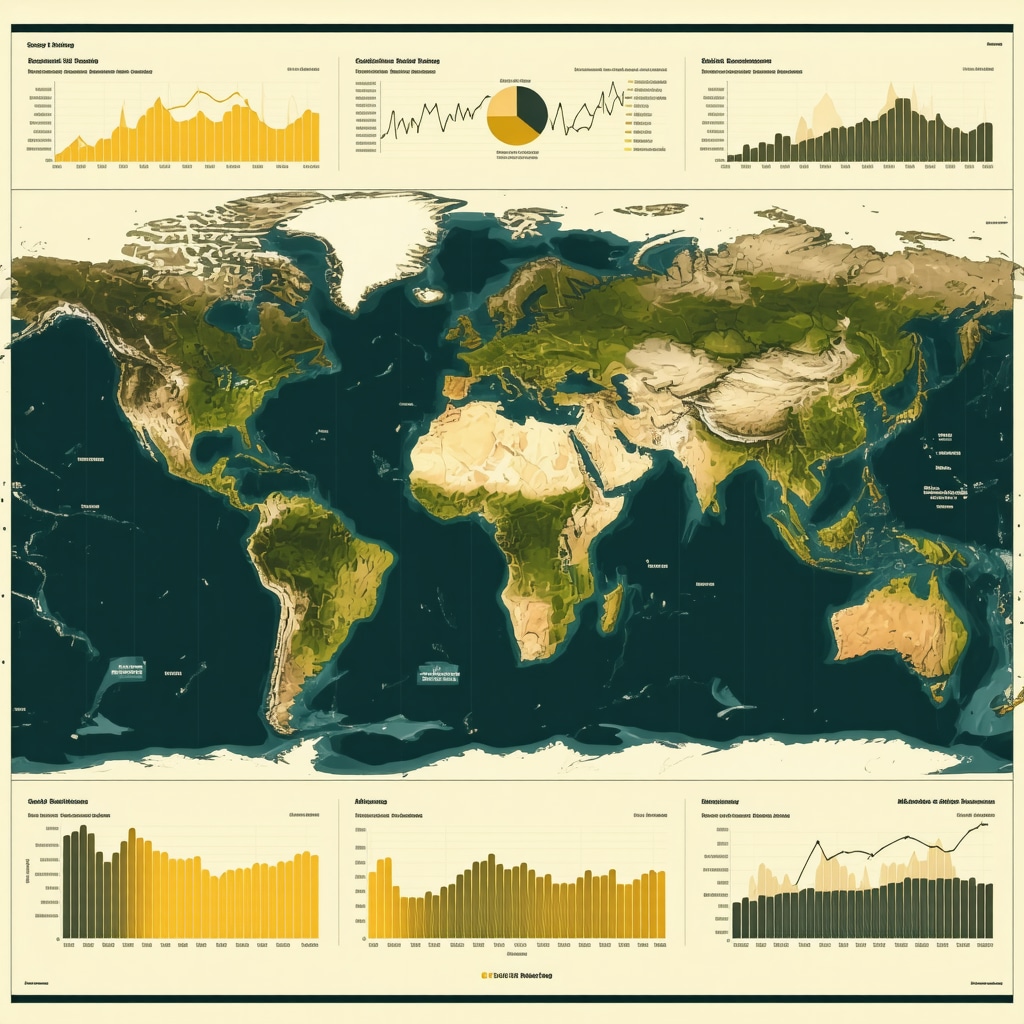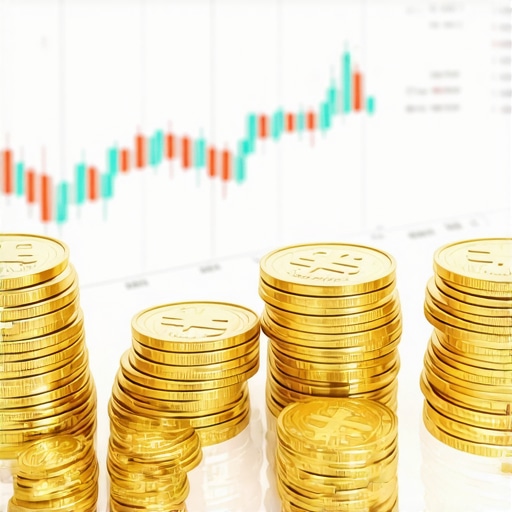Unearthing Potential: Why Gold Mining Stocks Deserve Your Attention Now
In the ever-shifting landscape of investment, gold mining stocks stand out as compelling vehicles for growth, especially in 2029’s volatile economic climate. Beyond the allure of physical gold, these equities offer a unique blend of exposure to gold’s value appreciation and the operational leverage of mining companies. As inflationary pressures persist and geopolitical uncertainties ripple through markets, savvy investors are increasingly turning to gold mining stocks as a strategic growth opportunity.
Mining Giants and Emerging Players: Navigating the Gold Equity Spectrum
Not all gold mining stocks are created equal. Industry titans like Newmont Corporation and Barrick Gold boast extensive reserves, diversified operations, and robust cash flows, which provide stability amid market fluctuations. Meanwhile, junior miners and mid-tier companies often present higher growth potential due to exploration successes and expansion projects, albeit with increased risk. Understanding this spectrum is vital for tailoring your investment strategy to balance risk and reward effectively.
How Do Operational Efficiency and Resource Quality Affect Gold Mining Stock Performance?
Operational efficiency — including cost control, extraction techniques, and asset management — alongside the quality and grade of mineral resources, critically influences mining stocks’ profitability and stock appreciation. Companies with lower all-in sustaining costs (AISC) and high-grade reserves typically weather price dips better and capitalize more during bull runs. For example, Newmont’s continuous investment in technology has optimized their extraction efficiency, directly impacting shareholder returns positively.
Geopolitical and Environmental Factors: The Hidden Catalysts
Geopolitical stability in mining regions, regulatory frameworks, and environmental policies significantly affect gold mining stocks. Mines located in politically stable countries with supportive mining legislation tend to offer safer investment environments. Concurrently, companies advancing sustainable mining practices and reducing carbon footprints are attracting ESG-conscious investors, thus potentially enhancing stock valuations. Monitoring these factors can provide foresight into which stocks might outperform.
Market Sentiment and Gold Price Dynamics: Timing Your Entry
Gold prices are influenced by currency fluctuations, interest rates, and global economic data. Mining stocks often amplify gold price movements, making timing crucial. When gold prices surge, mining companies’ earnings growth can be exponential, but during corrections, stocks may underperform. Investors keen on capturing growth should stay informed through reliable forecasts and market analysis, such as insights provided by the 2029 gold price forecasts.
Capitalizing on Growth: Strategic Tips for Investors
Investing in gold mining stocks requires a blend of fundamental analysis, market awareness, and patience. Diversifying across market caps and geographic locations can mitigate risks. Additionally, staying abreast of quarterly earnings reports, exploration news, and geopolitical developments enhances decision-making. For beginners, resources like the beginners guide to investing in gold mining stocks provide valuable foundational knowledge.
Join the Conversation: Share Your Insights and Experiences
If you’ve explored gold mining stocks or are considering them for your portfolio, we’d love to hear your thoughts. Share your experiences or questions in the comments below to foster a community of informed investors navigating these lucrative opportunities together.
For authoritative insights on the interplay between gold demand trends and investment strategies, the World Gold Council offers comprehensive reports worth exploring.
Lessons Learned from My Own Gold Mining Stock Journey
Reflecting on my experience investing in gold mining stocks, one thing that stands out is the importance of patience and continual learning. Early on, I was drawn to the excitement of junior miners boasting high growth potential, only to face the turbulence of fluctuating gold prices and operational setbacks. Over time, I learned to balance my portfolio between established giants and promising smaller companies, which helped me navigate volatility more smoothly.
For instance, investing in companies like Newmont provided a reassuring backbone to my portfolio during downturns, while carefully selected exploration-focused stocks occasionally delivered rewarding spikes. This blend, combined with staying updated on mining news and geopolitical developments, has been key in managing both risk and opportunity.
Understanding the Broader Economic Context: Why It Matters
Gold mining stocks don’t exist in a vacuum; they are deeply intertwined with global economic factors such as inflation trends, currency strength, and monetary policies. When inflation rises, gold often becomes a safe haven, lifting mining stocks along with it. Conversely, when economic confidence is high and interest rates rise, investors might lean towards equities with faster growth, sometimes at the expense of gold-related assets.
A fascinating resource I often turn to is the World Gold Council, which offers detailed analysis on gold demand trends and their impact on investment strategies. Their reports helped me better grasp how factors like central bank buying and jewelry demand can influence gold prices and, by extension, mining stocks’ performance.
Have You Ever Considered How ESG Initiatives Affect Your Gold Mining Investments?
With sustainability becoming a major focus in investing, I’ve noticed that companies actively improving their environmental and social governance (ESG) practices tend to attract more interest from institutional investors. This trend not only supports ethical investing but also often correlates with better long-term operational resilience. Personally, I now prioritize mining stocks that demonstrate strong commitments to reducing environmental impact and fostering positive community relations.
Practical Tips for Staying Ahead as a Gold Mining Stock Investor
Based on my journey, here are a few practical tips I recommend:
- Diversify across regions: Political stability varies widely. Investing in companies operating in different countries helps mitigate geopolitical risks.
- Keep an eye on cost metrics: Understanding a company’s all-in sustaining costs (AISC) gives insight into how well they can handle gold price fluctuations.
- Follow industry news regularly: Quarterly earnings, exploration updates, and regulatory changes can signal upcoming stock movements.
- Use trusted guides: For beginners, reading resources like the beginners guide to investing in gold mining stocks can build a strong foundation.
Engage with the Community and Expand Your Knowledge
I find that discussing ideas with fellow investors often leads to new perspectives and strategies. If you have insights or questions about gold mining stocks, please share them in the comments below. Your experiences could help others navigate this complex yet rewarding sector.
For those interested in broadening their gold investment scope, exploring top gold investment strategies during volatile times might offer valuable ideas to diversify and protect your wealth.
Decoding ESG Integration: Transforming Gold Mining Stocks into Sustainable Investments
Environmental, Social, and Governance (ESG) criteria are no longer peripheral considerations but central to evaluating gold mining stocks’ future viability. Investors increasingly demand transparency and accountability, pushing mining companies to innovate beyond traditional extraction methods. Incorporating renewable energy sources, minimizing water usage, and rehabilitating mining sites have become critical benchmarks. This shift not only reduces operational risks related to regulatory penalties and reputational damage but also enhances access to capital from ESG-focused funds.
For instance, Barrick Gold’s advancement in carbon neutrality initiatives has positioned it favorably among institutional investors, reflecting a broader industry trend toward sustainable mining. The World Gold Council’s ESG Guidance Framework provides an authoritative blueprint for companies to align their practices with investor expectations, underscoring ESG’s tangible impact on stock performance (World Gold Council Sustainability Framework).
How Does ESG Performance Quantitatively Influence Gold Mining Stocks’ Valuation Amid Market Volatility?
Quantitative studies suggest that gold mining firms with higher ESG scores tend to experience reduced cost of capital and lower share price volatility. This is partly due to enhanced stakeholder trust and mitigated exposure to environmental fines or social conflicts. Sophisticated investors utilize ESG ratings alongside traditional financial metrics to forecast resilience and growth potential, especially during economic downturns.
Moreover, ESG integration correlates with operational efficiencies; companies investing in cleaner technologies often realize long-term cost savings, improving their all-in sustaining cost (AISC) metrics and thus competitiveness.
Leveraging Advanced Financial Instruments: Options and Futures in Gold Mining Equity Strategies
Beyond straightforward equity purchases, advanced investors increasingly employ derivatives such as options and futures to hedge risk or speculate on gold mining stocks’ movements. These instruments provide strategic flexibility, allowing for position protection during gold price corrections or amplifying gains during bullish trends.
For example, call options on mining stocks can be utilized to capture upside potential while limiting downside risk. Futures contracts on gold prices offer direct hedging against commodity price fluctuations that heavily influence mining profitability.
Understanding the nuanced interplay between gold prices, mining stock volatility, and derivative instruments requires a sophisticated grasp of both commodity markets and equity behavior. Resources like the CME Group’s Commodity Trading Education provide expert-level frameworks for investors aiming to incorporate these strategies effectively.
Deep Dive into Geopolitical Risk Modeling: Anticipating Market Shifts in Gold Mining Stocks
Geopolitical risk assessment is evolving from qualitative judgement calls to more data-driven, model-based approaches. Utilizing geopolitical risk indices, satellite data on mining operations, and real-time news analytics, investors can quantify and anticipate potential disruptions that impact mining stocks.
Such models incorporate variables like export restrictions, labor disputes, and environmental legislation changes across mining jurisdictions. By overlaying these with gold price forecasts, investors can dynamically adjust portfolios to mitigate risks or capitalize on emerging opportunities.
Integrating artificial intelligence and machine learning further refines these predictive models, enabling proactive rather than reactive investment decisions in a sector often vulnerable to sudden geopolitical shifts.
Call to Action: Elevate Your Gold Mining Stock Investments with In-Depth Expertise
To master the complexities of gold mining stock investment, especially in 2029’s dynamic landscape, embracing ESG analysis, derivative strategies, and sophisticated risk modeling is paramount. Engage with authoritative resources such as the World Gold Council and CME Group, and consider consulting financial experts specializing in commodity equities.
Stay ahead by deepening your knowledge through advanced courses and community discussions, and transform your portfolio to not only withstand volatility but thrive amid it.

Harnessing ESG Metrics: The Future-Forward Approach to Gold Mining Investment
In the contemporary investment milieu, Environmental, Social, and Governance (ESG) factors are reshaping how gold mining stocks are evaluated and valued. Investors are moving beyond traditional financials to integrate ESG analytics, recognizing that sustainable practices correlate strongly with operational resilience and shareholder value. Companies that adopt renewable energy, enforce rigorous community engagement, and enhance transparency are not only mitigating regulatory risks but are also unlocking preferential access to capital markets.
Notably, Barrick Gold’s pioneering carbon neutrality initiative exemplifies this paradigm shift, attracting ESG-conscious institutional capital and fostering investor confidence. The World Gold Council Sustainability Framework offers comprehensive guidance, underscoring how ESG integration tangibly influences mining equities’ performance.
What Quantitative Evidence Supports ESG’s Impact on Gold Mining Stocks During Market Volatility?
Empirical research reveals that mining firms with superior ESG scores exhibit lower cost of capital and diminished share price volatility, particularly amid economic downturns. These advantages stem from enhanced stakeholder trust, reduced incidence of environmental litigation, and smoother regulatory navigation. Advanced investors employ ESG ratings alongside traditional valuation metrics to forecast resilience and identify undervalued opportunities. Moreover, companies investing in cleaner technologies often realize operational cost efficiencies, reflected in improved all-in sustaining cost (AISC) figures, which further buttress their competitive positioning.
Capital Markets Sophistication: Using Derivatives to Manage Exposure in Gold Mining Equities
Beyond conventional equity holdings, sophisticated investors often leverage options and futures to tactically hedge or amplify positions in gold mining stocks. Options strategies, such as protective puts or covered calls, provide tailored risk-reward profiles, enabling portfolio protection during gold price corrections and capitalizing on bullish momentum.
Futures contracts linked to gold prices afford direct commodity exposure, offering an effective hedge against underlying mining operational risks. Mastery of these instruments demands a nuanced understanding of commodity-equity correlations, volatility dynamics, and expiration cycles. The CME Group’s Commodity Trading Education portal serves as an invaluable resource for investors seeking to deepen expertise in these derivative strategies.
Geopolitical Risk Analytics: Predictive Models Enhancing Portfolio Robustness
Emerging technologies and data analytics are revolutionizing how geopolitical risk is assessed in the gold mining sector. Quantitative models now integrate geopolitical risk indices, satellite imagery of mining operations, and real-time news sentiment analysis to forecast disruptions such as export embargoes, labor unrest, or environmental regulation shifts.
Incorporating artificial intelligence and machine learning algorithms, these tools enable investors to proactively adjust exposure, optimize asset allocation, and capitalize on arbitrage opportunities created by transient geopolitical events. This data-driven approach transcends subjective assessments, offering a competitive edge in navigating the sector’s inherent volatility.
Call to Action: Elevate Your Gold Mining Stock Portfolio with Cutting-Edge Insights
To thrive in 2029’s intricate gold mining investment landscape, embracing ESG integration, derivative instruments, and advanced geopolitical risk analytics is essential. Engage with leading authorities like the World Gold Council and CME Group, and consider collaborating with financial advisors specializing in commodity equities to refine your strategy. Deepen your expertise through advanced courses and active community participation to transform volatility into opportunity and fortify your portfolio’s resilience.

Frequently Asked Questions (FAQ)
What are the primary factors influencing gold mining stocks’ performance?
Gold mining stocks are influenced by gold prices, operational efficiency, geopolitical stability, environmental regulations, and market sentiment. Cost management, particularly the all-in sustaining cost (AISC), and resource quality also play critical roles in profitability and stock valuation.
How does ESG integration impact gold mining stock investments?
ESG integration enhances long-term resilience by reducing regulatory risks and operational costs. Companies with strong ESG practices often enjoy lower capital costs, greater investor confidence, and reduced share price volatility, especially during market downturns. This trend is increasingly significant as sustainable investment criteria shape capital flows.
Can derivatives like options and futures be effectively used with gold mining stocks?
Yes. Advanced investors use options and futures to hedge against gold price fluctuations or to leverage bullish trends in mining equities. These instruments provide flexibility in risk management but require a sophisticated understanding of commodity and equity market dynamics.
What role does geopolitical risk play in gold mining stocks?
Geopolitical risks such as political instability, regulatory changes, or labor disputes can cause sudden disruptions in mining operations and impact stock performance. Modern risk modeling that incorporates data analytics and AI helps investors anticipate and mitigate these risks proactively.
Why should an investor diversify across different gold mining companies and regions?
Diversification helps balance risk by mitigating exposure to localized geopolitical issues, regulatory changes, and operational challenges. Combining established giants with junior miners across various jurisdictions optimizes growth potential while controlling volatility.
How can beginners get started with investing in gold mining stocks?
Beginners should start with foundational resources like comprehensive guides, focus on well-established companies with stable operations, and monitor key metrics such as AISC and gold price trends. Gradually expanding knowledge through industry news and expert analyses is essential for informed decision-making.
What economic trends most affect gold mining stocks in 2029?
Inflation rates, currency strength (especially the US dollar), interest rate policies, and global economic uncertainty significantly influence gold prices and thus mining stocks. Typically, inflationary environments and geopolitical tensions boost gold demand, benefiting mining equities.
How do operational efficiencies influence mining company valuations?
Companies with optimized extraction methods and lower operational costs can maintain profitability even when gold prices decline. High operational efficiency improves margins and cash flow, making these stocks more attractive and resilient in volatile markets.
What is the significance of the all-in sustaining cost (AISC) metric?
AISC represents the comprehensive cost of mining gold, including operational and sustaining capital expenditures. Lower AISC indicates a company’s ability to remain profitable at lower gold prices, contributing to better stock performance and investor confidence.
How can investors stay updated on developments affecting gold mining stocks?
Following quarterly earnings reports, exploration updates, geopolitical news, and ESG progress reports is crucial. Utilizing trusted platforms and engaging with investor communities also helps maintain an informed perspective for timely investment decisions.
Trusted External Sources
- World Gold Council: Provides in-depth research on gold demand trends, ESG guidelines, and investment frameworks essential for understanding gold mining stocks’ market dynamics.
- CME Group Commodity Trading Education: Offers expert-level courses and resources on derivatives like options and futures, enabling investors to effectively manage risk in gold mining equities.
- Financial Times – Mining Sector Analysis: Delivers comprehensive news, geopolitical risk insights, and financial analysis relevant to gold mining companies globally.
- Bloomberg Intelligence – Metals & Mining: Supplies detailed data-driven reports on mining company performance, operational costs, and market forecasts, crucial for advanced investors.
- Harvard Business School – Mining Case Studies: Academic research and case studies exploring operational efficiencies and ESG integration in mining firms, providing a deep strategic perspective.
Conclusion: Mastering Gold Mining Stock Investments in 2029
Gold mining stocks remain a potent avenue for investors seeking growth intertwined with gold’s intrinsic value and operational leverage. Navigating this sector requires a nuanced understanding of factors ranging from cost efficiencies and resource quality to geopolitical risks and ESG commitments. Integrating advanced financial instruments and sophisticated risk models further refines portfolio strategies amid market volatility.
As 2029 unfolds, embracing sustainability frameworks and leveraging cutting-edge analytics will distinguish successful investors. By staying informed through authoritative sources and engaging with expert communities, investors can transform challenges into opportunities, fortifying their portfolios against uncertainty. Dive deeper into gold mining equity strategies, share your insights, and continue exploring expert content to elevate your investment acumen today.










